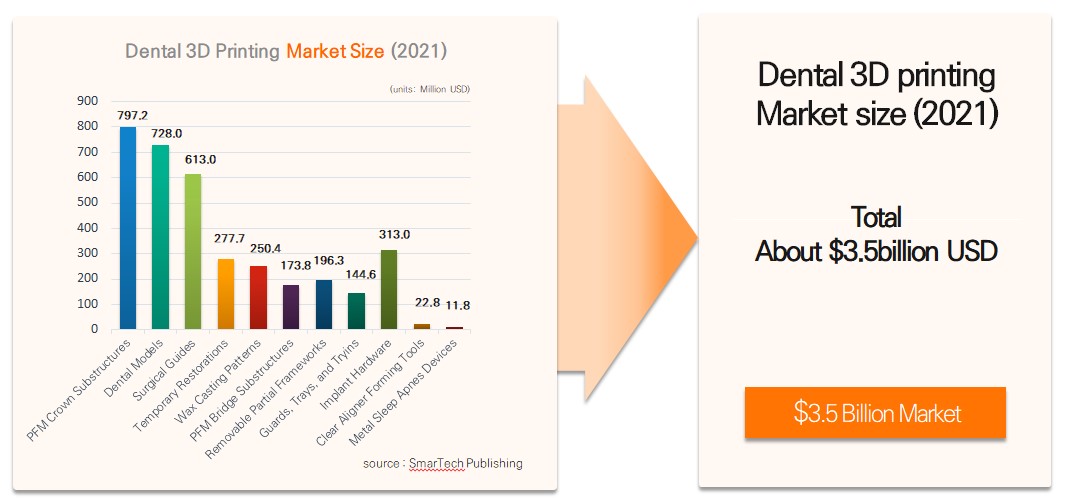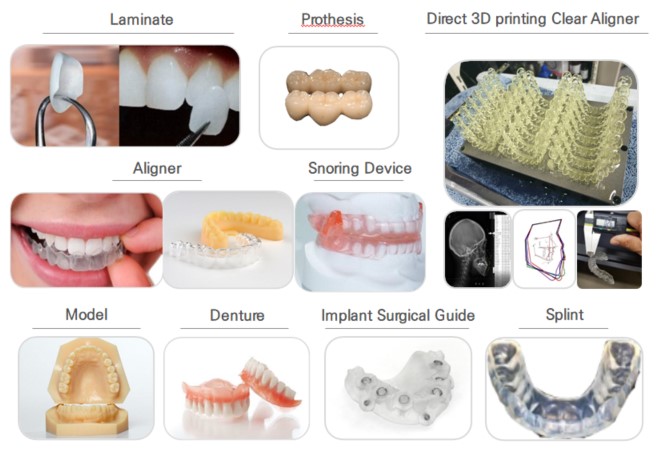
Although the 3D printing market share is less than 10%, it is forecast to grow to KRW 4 trillion in 2021.
Even though the problems of the 3D printing industry are caused by lack of understanding of 3D printing characteristics, the biggest reason is the low durability of printing materials. What is important in developing new materials for 3D printers is high strength, high shock resistance, and high modulus of elasticity.
Currently, the sector that uses 3D printing most actively is dentistry. As it is directly related to the human body, the technical level of difficulty is high. Therefore, the safety and mass production of materials used in dentistry are especially important, and the development of such new material has become the foremost task.
There is a company that developed the material for permanent dental prosthesis and clear aligner material whose printing is possible, and both materials can meet the requirements above. This company is Graphy, Inc. (CEO: Sim Un-seob). Graphy is a manufacturer of photopolymer resins for 3D printing, and it developed “S Plastic” as well as the dental 3D printing material brand “Tera Harz.”
This material shows higher strength and elasticity than the existing reinforced plastic film, and its thickness can be freely controlled and manufactured depending on the necessary force so partial orthodontic appliance and dental prosthesis can be printed. As such, clear aligners that fit patients’ teeth can be manufactured.
Although 3D printer materials should be outstanding themselves, they need to be optimized to 3D printers. This is why Graphy has strong competitiveness. The material developed by Graphy has compounded soft carbon backbone and carbon backbone hardened at high temperature using a special technique. It is flexible and heat-resistant.
Tera Harz is designed to be harmless to the human body but has super engineering plastic level in terms of strength to manufacture dental prosthesis. Resin is not simply mixed but is compounded at the solid raw material step. This compounding technology enables controlling the molecular formula, so customization depending on customer needs becomes possible. Also, the material used is an eco-friendly general material, and the shape is restored when hot water is poured into it; even sterilization is possible.
Whereas the existing clear aligner needs 1~2 weeks’ manufacturing time, the manufacturing time is reduced to within an hour if 3D printing is performed with the material developed by Graphy. Cost and processes are also innovatively streamlined as no film and vacuum forming process is necessary.
Thanks to the innovative time saving, a new clear aligner can be easily and quickly provided according to the patient’s teeth state change. Orthodontic treatment is completed within a short period of time by using a method of putting the new appliance (clear aligner) on the patient’s teeth step by step with 3 to 7 days’ interval.
The total 3D printing market in the dental field is valued at USD 3.5 billion (KRW 4 trillion). It is growing much faster than the oral scanner market. The total 3D printing market size is forecast to reach USD 26.1 billion in 2022.
In its report “Opportunity Analysis of 2018 Dental 3D Printing and 10-Year Forecast,” world leader SmarTech Publishing – which provides in-depth industrial analysis service to the additive manufacturing and 3D printing industry – expects USD 9.5 billion worth of opportunities to be created by 2027. The dental and medical fields were cited as a high value-added market in the 3D printing sector.
Clear Aligner as a New Market
A much bigger market than the implant market is the clear aligner market. The No. 1 clear aligner company’s sales and market capitalization surpassed those of the top company in implants. The clear aligner market is much bigger than the implant market in terms of target patients.
China is considered the second largest clear aligner market. Given its features such as the latest technology penetrating quickly (simple and convenient payment not using credit cards, smartphone not using home phone etc.), the Chinese clear aligner market is likely to grow rapidly.
The global orthodontic market is valued at KRW 40 trillion (source: Robert W. Baird & Co. Report, 2014). Leading global company “Invisalign” posted KRW 1.6 trillion of sales with clear aligners in 2017. Its annual average growth rate was 8.0%, and its sales growth in 2021 is forecast to be USD 4.71 billion.
Increase Speed of Clear Aligner with High Growth Rate is Two Times Higher
Whereas the growth of the existing traditional orthodontic market (metal wire, bracket) — estimated at USD 800 million in 2016 — is stagnant, the USD 1.5 billion clear aligner market has maintained a two-digit growth rate targeting patients in the 13~19 age group who are sensitive to appearance, and its growth rate is two times higher compared to the total orthodontic market.
Actually, an analysis predicts more than 100-fold growth effect if the printing aligner is applied. Specifically, if 3D printed clear aligner patients are assumed to account for 30% of the total orthodontic patients, it estimated about 8 million people, which is about 100-fold of the past method clear alignment patient.
3D Printing Market Estimated to be Valued at KRW 4 Trillion Next Year
The ratio of 3D printing technology in the global orthodontic medical service market is on the rise. The field where digitalization is fastest in the medical service is dentistry. By 2021, the market is estimated to be valued at KRW 4 trillion.
According to dental clinic director Kim Young-hoon, however, 3D printing is a general trend and a great revolution in the future. “3D printing was hailed as a new technology representing the Fourth Industrial Revolution a few years ago, but it is no longer new technology,” Graphy CEO Sim Un-seob noted.
In the 3D printing market, material innovation has become the innovation of the total printing industry. The development speed of 3D printer, dubbed as the main player of the Fourth Industrial Revolution several years ago, has continuously been improved, but not the durability of existing materials. Thus, the improvement of materials remains a huge task. Today, the world pays attention to the fact that the material was developed in Korea.
Actually, the dissemination of 3D printers was delayed as it focused on printer technology rather than materials at the initial stages. The material developed by Graphy is rated as matchless. If Graphy’s material is used, full and flexible dentures are possible in addition to crown & bridge.
“Although milling is used a lot nowadays, the use of various materials is impossible in view of accuracy or various costs. Milling equipment is expensive, and considerable relevant expenses are incurred, not to mention specialized technology. 3D printing is simple, however. Milling should undergo a sintering process. In other words, much time is required as a process hardening glass ingredient within ceramic. But 3D printing can finish in 10 minutes without a specific technology,” dental clinic director Kim said.
Now, a revolution is taking place in dental treatment. Small 3D printing equipment can be purchased at an affordable price. Inlay, onlay, and crown — which are not complex cases — can be utilized by dentists right away. Less time is required, not to mention lower expenses. 3D printing is really good for patients, which is a good merit.
Attraction of more than USD 10 million investments from Venture Capital
Graphy was selected as a representative startup of materials, parts, and equipment by the Ministry of SMEs and Startups, attracting cumulative investment of KRW 15 billion from venture capital.
Contact
Phone : 82-2-864-3056
website: www.itgraphy.com
Address: 6th Fl, Ace GasanFORHU, 225, Gasiandigital-1ro, Geumcheon-gu, Seoul, Korea
Subscribe to Our Email Newsletter
Stay up-to-date on all the latest news from the 3D printing industry and receive information and offers from third party vendors.
Print Services
Upload your 3D Models and get them printed quickly and efficiently.
You May Also Like
Consolidation in AM: How 2025 Is Shaping the Industry’s New Normal
The first half of 2025 has been marked by a clear shift in the additive manufacturing (AM) industry. Companies are no longer just focused on developing new tech by themselves....
Etsy Design Rule Change Reduces Selection of 3D Printed Goods
Online marketplace Etsy has implemented a rule change requiring all 3D printed goods on the site to be original designs. The update to the site’s Creativity Standards states, ¨Items produced using...
U.S. Congress Calls Out 3D Printing in Proposal for Commercial Reserve Manufacturing Network
Last week, the U.S. House of Representatives’ Appropriations Committee moved the FY 2026 defense bill forward to the House floor. Included in the legislation is a $131 million proposal for...
Transforming From Tourist to Native: Duro CEO Michael Corr Explains Why the Company Rebuilt its PLM Software on AI
In these early innings of the AI boom, many market analysts have expressed concern that AI spend has gotten too far ahead of the technology’s proven ability to deliver significant...


































